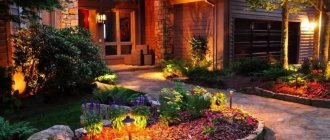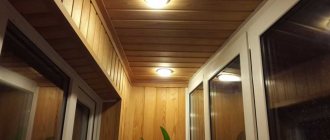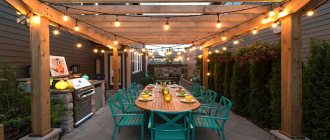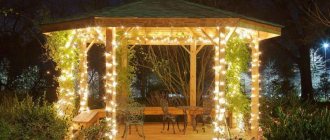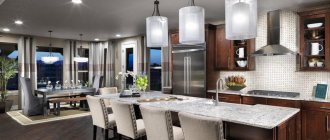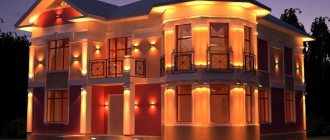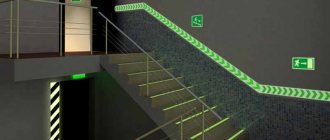To get at least a little escape from the endless bustle of big cities, their inhabitants love to spend weekends at their summer cottage. Alas, ordinary people do not always have time to complete all their business before dawn or spend a pleasant evening on the street because it gets dark. Well-equipped lighting in the country helps solve this issue. And in order for street lighting in a suburban area to be safe and as efficient as possible, it is necessary to comply with the basic requirements for lighting devices.
Primary requirements
Due to the fact that lighting devices in a dacha perform a wide variety of functions and can be located in the open air and in close proximity to places of passage or permanent residence, they are subject to a number of requirements:
- The dacha lighting system must provide a sufficient level of safety even in emergency situations. In the event of short circuits or insulation breakdown, the installed protection is selected in such a way as to de-energize the section of the circuit in the country in time.
- For electrical wiring, cable and wire products are selected in accordance with the characteristics of the installation location. The cross section is selected according to the load that is planned to be connected to it. For external placement, brands with double insulation are selected, for external installation - with armor or in a metal box, corrugation.
- The outdoor lighting control system at the dacha must provide for both permanent connections via switches and the ability to receive voltage from the network through a plug socket. Their location is planned at a convenient height, taking into account the level of precipitation in specific areas of the site. The degree of dust and moisture resistance of sockets, switches, lamps and distribution boxes is selected according to the conditions in which they will be used.
- The type of lighting elements and its power are selected depending on their purpose (functional, decorative, marking, security, etc.)
- Due to the large area in which sufficient visibility must be ensured, energy-saving lamps - fluorescent and LED lamps - must be used for artificial lighting.
- In places where there is free access to current-carrying elements, power should be provided from a safe low voltage of 12V.
Compliance with the above requirements for lighting your dacha will not only make yard lighting effective, but also not costly. All of the above points must be taken into account at the design stage, so we will consider them in more detail below.
Types of lamps for the garden
Street lighting devices perform two functions: utilitarian and aesthetic. A dacha differs from an apartment in that some of the household elements are located on the site: a bathhouse, a gazebo, a summer kitchen. Therefore, regular lighting runs along the paths of movement around the site to avoid accidental injuries in the event of a fall. The aesthetic component is taken into account when drawing up a landscape design project. Lamps highlight plant compositions and small architectural forms from the darkness; lighting works to create coziness. Lanterns on the site easily combine both functions: a private area, equipped with lamps, becomes a cozy and lived-in cottage.
All lights can be divided by type of mounting:
- wall-mounted – a bit like sconces;
- ground - highlight the boundaries of the tracks;
- floating for the surface of an artificial pond;
- portable with handle;
- “floor lamp” - reminiscent of those used for city streets.
By type of lighting element:
- LED;
- powered by a regular incandescent light bulb;
- with a fluorescent lamp at the base;
- halogen;
- solar panels.
Wall lanterns are easy to install on existing surfaces: walls and doors for lighting stairs, verandas and adjacent areas, and interior decoration. The lantern can be made in a simple forged style or be a simple “tablet”. The lighting element creates a soft diffused glow or gives a precisely directed beam of light. The wall lamp also performs a security function. How? Choose options that respond to movement and install them at the entrance to the house and on the territory itself. By switching on during movements, the device also saves energy.
Floor lamps look amazing over a large area. For example, when delineating an alley or the main decorative driveway. If the design is designed to be activated by human movement, the effect is incredible. They are used everywhere: at the main gate, entrance door, to illuminate outbuildings. It is possible to position the switch at hand level, then use becomes as convenient as possible.
A mushroom-shaped lantern is a great design idea. In some ways it resembles a floor lamp, but it creates a wonderful play of light. The dome of such a lamp is covered with a reflective film, so beautiful dispersion is obtained.
Pole lamps work on a similar principle. They are, of course, more stylized and have a simpler shape than a floor lamp, but they are very effective.
Ground lights are usually very compact and are installed directly into the soil using a sharp stem. They often use light storage batteries. Their glow is soft and point-like: they perfectly outline paths and paths. Such lamps are easy to move, visually changing the configuration of the paths.
“Street chandelier” is almost the same as an ordinary chandelier, but is designed for open air. It is most logical to install it in an open gazebo. In fact, this is also a street lamp, but not so much utilitarian as beautiful. This lighting element requires special mounting.
Cottage lighting options
Due to the wide variety of lighting devices today, they can perform a fairly wide range of tasks, determining not only the level of visibility on the site, but also the design of landscape design, the functional highlighting of any locations, etc.
In total, there are four main lighting options for personal plots, which differ in their purpose, location and other features. Let's look at each type in more detail.
Functional
Functional lighting
Functional lighting is designed to provide sufficient visibility in a specific area of the dacha. Depending on the task at hand, functional lighting can be used for general lighting of landscape elements or for any technological objects (barns, garages, animal pens, etc.).
The main requirement for this option is that street lights must have a fairly good level of light transmission. The space illuminated by them receives sufficient visibility, in which you can not only have a good rest, but also perform certain categories of work.
Decorative
An example of decorative lighting
Decorative lighting does not carry any global load; its main task is to decorate the area in accordance with the design decision. It allows you to make your garden area more interesting and attractive at night.
This type of backlight is used as:
- single lamps in flower beds;
- façade lighting;
- lining the lines of decorative landscape elements;
- highlighting certain details (trees, bushes, etc.).
Most often, the decorative function is used in the garden, recreation area, near bodies of water to illuminate the veranda or the entrance to the room. For a veranda or other resting place, spotlights are used to create a pleasant, dim light in the desired location. It is good to use garlands of incandescent lamps in a retro style or LED strips for a modern design for decorative lighting of a family vacation spot.
Marking
Marking lighting
This type of lighting is intended for marking any elements or details of the territory of the dacha:
- paths - organized through low-power models installed along the edges of the sidewalk; path lighting is used to highlight the pedestrian area at night, it is not intended to provide sufficient visibility on it;
- steps - can be installed both on the steps themselves and in the wall directly above them; when installed in the floor covering, the lamp body is selected taking into account the mechanical impact that will be exerted on it;
- gates - designed to improve the visibility of the passage area, allows you to navigate the area, performed with LED strips or other original lamps;
- fence - provides for the installation of floodlights along the perimeter of the site, creates a lighting design around the territory of the dacha, garden or vegetable garden.
Security
Security lighting
The main task of security lighting is to prevent illegal actions in relation to your property. It should be noted that there will be no physical impact on attackers, but psychological impact when turned on can have a noticeable effect. The most relevant places to use the security function are garages, gates, doors and windows, and the common space in front of the house.
It is very good for security lighting to use an automatic switching system that responds to movement in any location. This will not only save energy, but will also create an additional psychological effect and will act as an alarm for you that someone is walking around the yard or garden area.
Selection and installation of outdoor garden lamps
In order to obtain high-quality functional lighting, it is best to install floor lamps and spotlights that guarantee stable and uniform illumination of the desired areas. Thanks to a wide range of lanterns in color, shape and material for their manufacture, everyone can choose an element of their garden plot that emphasizes their style and overall design.
According to their purpose and appearance, decorative lighting elements (lamps) are divided into the following groups:
- Recessed lamps are light sources that are installed in the ground, decorative platforms, stairs and steps, the floor of gazebos and other buildings. Often, low-power and not very bright lamps are chosen for this, creating only an outline for paths and steps. Also, such lanterns can be used to illuminate the facade of a country house.
- Columns of various heights, which may differ in shape, style and color. Often such lamps are not sources of a bright luminous flux, because their main task is to illuminate individual landscape elements (benches, flower beds and artificial ponds), as well as paths and paths. Often used to decorate a site made in a classic style. Columns can have different shapes, for example, they are made in the shape of a mushroom, a bell, or a strict and even column.
- Bollards are a column lamp that extends out of the ground and is used to decorate an area made in one of the modern styles (loft, hi-tech or minimalism). Such lanterns are equipped with a reflector (reflector), which creates a directed luminous flux.
- Floating balls are waterproof lamps that are used to illuminate artificial bodies of water (swimming pool, fountain or artificial pond). Balls can have a glow of different colors, which creates a chic and spectacular spectacle.
- A floor lamp is a support with a spherical lamp installed on top, creating a uniform light flux.
- Light stands are cylindrical lamps that illuminate flower beds and flower beds, garden paths and hanging bridges.
Conditions that must be met when creating decorative lighting for it to be worthwhile:
- Accent lighting should be aimed at prominent elements of the landscape, architecture or surrounding landscape.
- To obtain optical depth of illumination, you need to create three zones: foreground illumination with muted light, a middle darkened background, and a background with uniform lighting.
- Emphasizing the symmetrical arrangement of objects.
- To illuminate the crowns of trees, you can use powerful lamps, but to highlight individual parts of the facade of the house, it is better to use lamps with soft and delicate light.
- Light of “cold” shades creates clear contours of the illuminated object. In addition, thanks to the cold spectrum, you can hide the visual imperfections of an area and visually expand its boundaries.
- You can create the effect of visually approaching an object using warm and soft light.
- Asymmetrical lighting – creates rhythm of space and the illusion of movement.
- The optimal shape for garden lamps is spherical, the surface is matte, the material is polycarbonate.
Drawing up a lighting scheme
As mentioned above, lighting in the country can be implemented in a variety of ways - from garden lanterns in the shape of fairy-tale characters to LED spotlights.
An important task when installing them is to maintain balance and achieve the required level of illumination along main and garden paths, in recreation areas, near a pond, utility block, etc. Inexperienced summer residents are guilty of uneven distribution of lighting fixtures on the territory, which is why there is an excess of light in one location, and some lamps are blocked by others, and in other locations it is even difficult to pass through.
The best way to plan everything in advance is to draw up a lighting plan that includes existing buildings, decorative and landscape elements. As a basis, you can take a plan of a summer cottage with a picture of everything that needs to be taken into account - paths, trees, flower beds, main and secondary buildings.
After this, the locations of the planned location of lighting devices are depicted on it. An example of such a scheme is shown in the figure below.
An example of a lighting scheme in a country house
When choosing a place to install street lamps, you need to think about the functions that you are going to assign to them. Accordingly, the placement height, their power and the direction of the light flux are immediately determined. After marking the installation points, you need to design the wiring on the electrical diagram. Through such planning, it is possible to achieve uniform lighting throughout the main territory and in functional locations.
Types of lamps used
Types of lighting devices for dachas are divided into several categories. The most relevant is the division by shape and external design, by type of lamps and by the method of installing the lamp. The division by design is the most difficult, since there are countless types, and it is not possible to sort them out, so we will leave the choice of external characteristics to your discretion.
Based on the type of lamp, lighting in the country is divided into the following categories:
- incandescent lamps - they are characterized by low cost, but quickly fail and produce the lowest light output - about 5 - 10 W/Lm;
- gas-discharge - also have a low cost, slightly superior to models with filament in light output of 12 - 15 Lm/W, slightly longer service life;
- luminescent - characterized by a light output of 25 - 50 Lm/W, but their main drawback is that they begin to act up at temperatures below zero;
- LED light bulbs are the most profitable option, despite the high cost of LED-type devices, they produce about 90 - 120 Lm/W and have the longest service life.
According to technical features, the following lighting devices are distinguished:
- floor - installed on the floor or ground, have different heights;
Floor lamps
- wall-mounted – placed on the walls of buildings or other structures;
Wall lights
- hanging lamps - all kinds of garlands, chandeliers, etc.;
Pendant lamps
- with directional flow - lighting devices with a reflector that can illuminate not only the territory, but also specific objects;
With directional flow
- built-in – installed flush with structural elements of the landscape (sidewalk, steps, etc.)
Recessed luminaires
- fiber optics - create interesting effects, especially popular for placement in water.
Fiber optic backlight
Mains powered or solar powered lanterns?
Gas-discharge, halogen, LED and incandescent lamps can be used as lamps for garden lighting. However, it is LED lamps that are especially popular, because they have an attractive appearance, long service life, high efficiency and minimal electrical energy consumption.
A more fashionable and modern solution is solar-powered lamps, which will reduce the cost of lighting and illumination of the garden. The autonomy of the lamps allows you not to monitor their operation, because they are charged during the daytime and glow at night. Another advantage of alternative lighting sources is the ability to abandon the cumbersome and costly installation of an electrical network.
Advantages of lamps powered by solar panels:
- Durability.
- Mobility.
- Easy to care for.
- Automation and complete autonomous operation.
Automation of turning on and off country lighting
The idea of creating a system that could control lighting in a country house with a given logic has been implemented for quite a long time. Therefore, today you can choose the most suitable option for you and purchase a special device.
The most common devices for automatic lighting are:
- photo relay - the system turns on the light in the dacha when the light level decreases and turns it off after sunrise, when the brightness of the sun's rays affects the photocell;
- motion sensor – allows you to turn on the lights in the dacha if movement is detected in any area;
- time relay - allows you to set the time for turning on and off the dacha lighting at a certain frequency;
- microcontroller (for example, based on Arduino) - a more modern solution for operating light in the countryside, allows you not only to set the frequency, but also to change the brightness, sequence, etc.
Useful tips
If you have taken on the task of making lighting in your dacha with your own hands, it will be useful for you to study the advice of experienced specialists on this issue:
- When installing garden lamps, it is better to choose models with a visor. They are much better protected from external factors and will last longer;
- To reduce energy consumption, install solar-powered lighting devices. They are completely autonomous and are perfect for marking or decorative lighting.
- If you are afraid of the costs of purchasing lighting fixtures, make original devices yourself.
- Using a battery, an inverter and an automatic switching system, you can create autonomous lighting.
- Do not connect wires using twists - this is not only unreliable, but also quite dangerous. Give preference to clamps, sleeves, soldered and bolted connections, and be sure to cover them with insulating material.
- When laying cable lines underground, use a pipe or channels; they will protect the conductor much better and can significantly simplify the process of replacing the cable if it fails.
